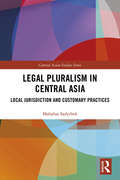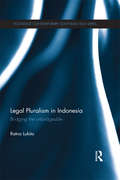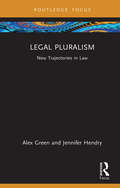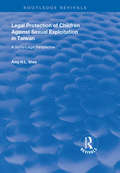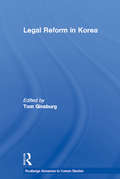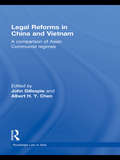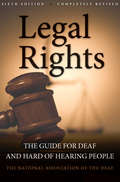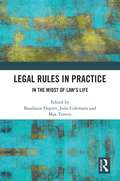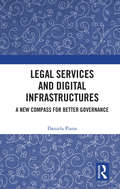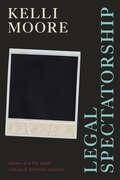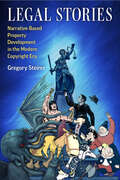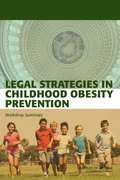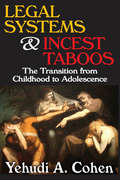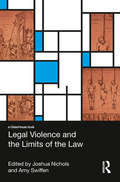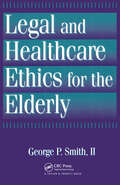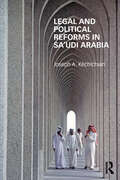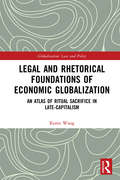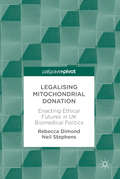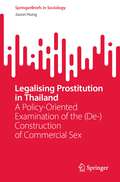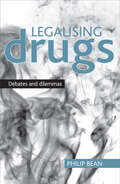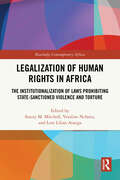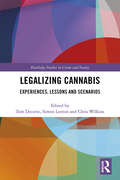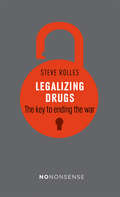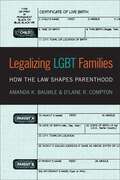- Table View
- List View
Legal Pluralism in Central Asia: Local Jurisdiction and Customary Practices (Central Asian Studies)
by Mahabat SadyrbekLegal Pluralism in Central Asia reports on historical, anthropological and legal research which examines customary legal practices in Kyrgyzstan and relates them to wider societal developments in Central Asia and further afield. Using the term legal pluralism, the book demonstrates that there is a spectrum of approaches, available avenues, forms of local law and indigenous popular justice in Kyrgyzstan’s predominantly rural communities, which can be labelled living law. Based on her extensive original research, Mahabat Sadyrbek shows how contemporary peoples systematically address challenging problems, such as disputes, violence, accidents, crime and other difficulties, and thereby seek justice, redress, punishment, compensation, readjustment of relations or closure. She demonstrates that local law, expressed through ritually structured communicative exchange, through dictums and proverbs with binding characters and different legal practices or processes undertaken in specific ways, deem the solutions appropriate and acceptable. The reader is thereby enabled to see the law in people’s deepest assumptions and beliefs, in codes of shame and honour, in local mores and ethics as well as in religious terms. In this way, the book reveals the dynamic, changing and living character of law in a specific context and in a region hitherto insufficiently researched within legal anthropology.
Legal Pluralism in Indonesia: Bridging the Unbridgeable (Routledge Contemporary Southeast Asia Series)
by Ratno LukitoWith the revival of Islamic law and adat (customary) law in the country, this book investigates the history and phenomenon of legal pluralism in Indonesia. It looks at how the ideal of modernity in Indonesia has been characterized by a state-driven effort in the post-colonial era to make the institution of law an inseparable part of national development. Focusing on the aspects of political and ‘conflictual’ domains of legal pluralism in Indonesia, the book discusses the understanding of the state’s attitude and behaviour towards the three largest legal traditions currently operative in the society: adat law, Islamic law and civil law. The first aspect is addressed by looking at how the state specifically deals with Islamic law and adat law, while the second is analysed in terms of actual cases of private interpersonal law, such as interfaith marriage, interfaith inheritance and gendered inheritance. The book goes on to look at how socio-political factors have influenced the relations between state and non-state laws, and how the state’s strategy of accommodation of legal pluralism has in fact largely depended on the extent to which those legal traditions have been able to conform to national ideology. It is a useful contribution for students and scholars of Asian Studies and Law.
Legal Pluralism: New Trajectories in Law (ISSN)
by Jennifer Hendry Alex GreenThis book examines the development and fundamental nature of legal pluralism. Legal pluralism evokes two distinctions: ‘state’ vs ‘non-state’ law; and ‘law’ vs ‘non-law’. As such, although this book focuses upon circumstances in which two or more legal orders compete to govern the same social space, it also addresses the nature of law in general. Drawing on material conflicts arising within jurisdictions such as Australia, Burundi, Cameroon, Gambia, the United States, and Zambia, this book explores the conceptual, moral, and political challenges that legal pluralism creates. Emphasising that non-state law carries no less dignity than that often ascribed to the legal orders of contemporary states, it advances a theoretically sophisticated argument in favour of recognising and respecting genuine cases of legal pluralism, wherever they arise. Accessible and thought provoking, this book will appeal to legal scholars, anthropologists, sociologists, and political and social philosophers as well as practising lawyers, judges, and policymakers who deal with issues of legal pluralism.
Legal Professionals in White-Collar Crime: Knowing, Thinking and Acting (Organization, Management and Crime - Organisation, Management und Kriminalität)
by Maria Eugenia TrombiniThis work is dedicated to map the modes of thinking and acting of legal professionals who work in white-collar crime. Lawyers, whose decisions generate economic and political consequences, stand at a strategic location between the state and key segments of society. This monograph’s approach is linked to the foundations of the sociology of knowledge, that culture antecedes and anchors social action. It starts by reconstructing the worldviews that legal professionals hold about corruption and its main participants, and then advances to examine decision-making. The author is introducing an innovative dataset comprised of interviews, court records and biographical data to investigate Brazilian lawyers (1985-2021). The study’s qualitative findings show a professional cognitive pattern that is apolitical and technical, and criticizes unskilled people working in the state administration more than businesspeople. The dominant mindset understands corporate-state relations as a self-feeding system that requires qualification and awareness of international trends to counter crime. The decision-making patterns confirm: (i) that prosecutors and judges prioritize the ends, fighting corruption, and use existing legislation and organizational resources to secure verdicts; (ii) the asymmetries between how bribe-payers and bribe-payees are treated.
Legal Protection of Children Against Sexual Exploitation in Taiwan: Socio-legal Perspective (Routledge Revivals)
by Amy H.L. SheeFirst published in 1998, this volume responds to child-prostitution being recognised as a major social problem in modern capitalist Taiwan. It is defined, both legally and socially, as a problem of ‘sexual transactions involving children and juveniles’, thus the issue of child maltreatment is submerged under other concerns. However, the main concern of this book is the protection of children from maltreatment, so related socio-legal measures will be examined by this parameter. During the social campaigns against child prostitution, structural problems such as police corruption, male sexual perversion, socio-economic inequality, and the maladjustment of aboriginal people in the modern Taiwanese society are subjugated to increasing criticism. Nevertheless, efforts to encounter any of them have had very limited accomplishment. This book intends to show that the functions of law in the prevention and treatment of the social problem of child prostitution cannot work as intended if those structural problems are not properly tackled. Suggestions are also made to address the need to reconceptualise the problem in the analytical framework of child maltreatment and to recommend the direction for reformation of policy and practice.
Legal Reform in Korea (Routledge Advances in Korean Studies #Vol. 5)
by Tom GinsburgLaw in Korea has historically been viewed as merely a tool of authoritarian rule, but since the transition to democracy in 1987 it has served a more important and visible role as a force for social change. With contributions from leading US and Korean scholars, Legal Reform in Korea explores this response to domestic and international pressures, applying a socio-legal perspective to both legal practices and the legal institutions themselves, which have become a major political issue throughout the developing world. An invaluable resource for students of Asian law and Korean studies.
Legal Reforms in China and Vietnam: A Comparison of Asian Communist Regimes (Routledge Law in Asia)
by John Gillespie Albert H.Y. ChenAlthough the adoption of market reforms has been a key factor leading to China’s recent economic growth, China continues to be governed by a communist party and has a socialist-influenced legal system. Vietnam, starting later, also with a socialist-influenced legal system, has followed a similar reform path, and other countries too are now looking towards China and Vietnam as models for development. This book provides a comprehensive, comparative assessment of legal developments in China and Vietnam, examining similarities and differences, and raising important questions such as: Is there a distinctive Chinese model, and/or a more general East Asian Model? If so, can it be flexibly applied to social and economic conditions in different countries? If it cannot be applied to a culturally and politically similar country like Vietnam, is the model transportable elsewhere in the world? Combining ‘micro’ or interpretive methods with ‘macro’ or structural traditions, the book provides a nuanced account of legal reforms in China and Vietnam, highlighting the factors likely to promote, change or resist the spread of the Chinese model.
Legal Rights, 6th Ed.: The Guide for Deaf and Hard of Hearing People
by National Association of the DeafThe standard handbook on law affecting deaf and hard of hearing people has been completely rewritten and updated. The sixth edition of Legal Rights: The Guide for Deaf and Hard of Hearing People meticulously describes those statutes that prohibit discrimination against deaf and hard of hearing people, and any others with physical challenges. Written in easy-to-understand language, the new edition describes the core legislation and laws and their critical importance since their inception: The Rehabilitation Act of 1973, the Individuals with Disabilities Education Act (IDEA), and the Americans with Disabilities Act (ADA). The new Legal Rights also explains the significant amendments to these laws, including the ADA Amendments Act (ADAAA) and new regulations to its Title II concerning public entities and Title III pertaining to public accommodations and commercial facilities. The reauthorization of IDEA expanded the No Child Left Behind Act requirement for highly qualified teachers to all students with disabilities. This new edition also tracks the trend of passing a Deaf and Hard of Hearing Children's Bill of Rights in a growing number of state legislatures. This completely new resource also delineates new legislation such as the Twenty-First Century Communications Video and Accessibility Act, which ensures access to the newest communications technology for deaf and hard of hearing people. Legal Rights also includes information on the use of interpreters in the legal system, securing its position as the most comprehensive reference of legal information for deaf and hard of hearing people now available.
Legal Rules in Practice: In the Midst of Law’s Life
by Baudouin Dupret; Julie Colemans; and Max TraversUnderstanding legal rules not as determinants of behavior but as points of reference for conduct, this volume considers the ways in which rules are invoked, referred to, interpreted, put forward or blurred. It also asks how both legal practitioners and lay participants conceive of and participate in the construction of facts and rules, and thus, through decisions, defenses, pleas, files, evidence, interviews and documents, actively participate in law’s life. With attention to the formulation of notions such as person, evidence, intention, cause and responsibility in the course of legal practices, Legal Rules in Practice provides the outlines of a praxiological anthropology of law – an anthropology that focuses on words, concepts and reasoning as actively used to solve conflicts with the help of legal rules. As such, it will appeal to sociologists, anthropologists and scholars of law with interests in ethnomethodology, rule-based conduct and practical reasoning.
Legal Services and Digital Infrastructures: A New Compass for Better Governance
by Daniela PianaThis book seeks to provide and promote a better understanding and a more responsive and inclusive governance of the automation and digital devices in public institutions, particularly the law and justice sector. Concerns related to AI design and use have been exacerbated recently with the recognition of the discriminatory potential that can be embedded into AI applications in public service institutions. This book examines issues relating to the assigning of responsibility in a public service produced and delivered on the basis of an automated mechanism. It encourages critical thinking about the legal services and the justice institutions as they are transformed by AI and automation. It raises awareness as to the prospect of transformation we face in terms of responsibility and of agency and the need to design a citizen-centered and human rights compliant system of technology assessment and AI monitoring and evaluation. The book calls for a comprehensive strategy to enable professional practitioners and decision makers to engage in the design of AI driven legal and justice services. The work draws on on-going research and consulting activities carried out by the author across different countries and different systems in the legal and justice sector. The book offers a critical approach to encourage a new mindset among legal professionals and the justice institutions thus empowering and training them to develop the necessary responsiveness and accountability in the justice sector and legal systems. It will also be of interest to researchers and academics working in the area of AI, Public Law, Human Rights and Criminal Justice.
Legal Spectatorship: Slavery and the Visual Culture of Domestic Violence
by Kelli MooreIn Legal Spectatorship Kelli Moore traces the political origins of the concept of domestic violence through visual culture in the United States. Tracing its appearance in Article IV of the Constitution, slave narratives, police notation, cybernetic theories of affect, criminal trials, and the “look” of the battered woman, Moore contends that domestic violence refers to more than violence between intimate partners—it denotes the mechanisms of racial hierarchy and oppression that undergird republican government in the United States. Moore connects the use of photographic evidence of domestic violence in courtrooms, which often stands in for women’s testimony, to slaves’ silent experience and witnessing of domestic abuse. Drawing on Harriet Jacobs’s Incidents in the Life of a Slave Girl, abolitionist print culture, courtroom witness testimony, and the work of Hortense Spillers, Moore shows how the logic of slavery and antiblack racism also dictates the silencing techniques of the contemporary domestic violence courtroom. By positioning testimony on contemporary domestic violence prosecution within the archive of slavery, Moore demonstrates that domestic violence and its image are haunted by black bodies, black flesh, and black freedom.Duke University Press Scholars of Color First Book Award recipient
Legal Stories: Narrative-Based Property Development in the Modern Copyright Era
by Gregory SteirerTracing the emergence of what the media industries today call transmedia, story worlds, and narrative franchises, Legal Stories provides a dual history of copyright law and narrative-based media development between the Copyright Act of 1909 and the Copyright Act of 1976. Drawing on archival material, including legal case files, and employing the principles of actor-network theory, Gregory Steirer demonstrates how the meaning and form of narrative-based property in the twentieth century was integral to the letter and practice of intellectual property law during this time. Steirer’s expansive view of intellectual property law encompasses not only statutes and judicial opinions, but also the everyday practices and productions of authors, editors, fans, and other legal laypersons. The result is a history of the law as improvisatory and accident-prone, taking place as often outside the courtroom as inside, and shaped as much by laypersons as lawyers. Through the examination of influential legal disputes involving early properties such as Dashiell Hammett’s Sam Spade, H. P. Lovecraft’s Cthulhu Mythos, and Robert E. Howard’s Conan the Barbarian, Steirer provides a ground’s eye view of how copyright law has operated and evolved in practice.
Legal Strategies in Childhood Obesity Prevention
by Lynn ParkerSince 1980, childhood obesity rates have more than tripled in the United States. Recent data show that almost one-third of children over 2 years of age are already overweight or obese. While the prevalence of childhood obesity appears to have plateaued in recent years, the magnitude of the problem remains unsustainably high and represents an enormous public health concern. All options for addressing the childhood obesity epidemic must therefore be explored. In the United States, legal approaches have successfully reduced other threats to public health, such as the lack of passive restraints in automobiles and the use of tobacco. The question then arises of whether laws, regulations, and litigation can likewise be used to change practices and policies that contribute to obesity. On October 21, 2010, the Institute of Medicine (IOM) held a workshop to bring together stakeholders to discuss the current and future legal strategies aimed at combating childhood obesity. Legal Strategies in Childhood Obesity Prevention summarizes the proceedings of that workshop. The report examines the challenges involved in implementing public health initiatives by using legal strategies to elicit change. It also discusses circumstances in which legal strategies are needed and effective. This workshop was created only to explore the boundaries of potential legal approaches to address childhood obesity, and therefore, does not contain recommendations for the use of such approaches.
Legal Systems and Incest Taboos: The Transition from Childhood to Adolescence
by John R. CommonsThe goal of this book is to investigate why there are two distinct notions of liability in the legal and ethical systems of different societies; the relationship between two sets of criteria of liability and the individual's evolution from childhood adolescence. The specific ways in which different societies cope with the transition from childhood to adolescence are important because a sense of responsibility, consonant with the goals of the society and survival of family and culture, is implanted in the growing child.The ways in which incest taboos are taught constitute one of the crucial modes by which a sense of responsibility is implanted within an individual during his transition from childhood to adolescence. The author places most of his focus on social systems, the transition from childhood to adolescence. Theoretical concerns are with the ways in which human biology and human social structures impact each other.The fact that wide variations do exist among societies in connection with certain types of incest taboos does not lead inevitably to the conclusion that there is no biological basis for the incest taboo. The immediate impression of variability can be misleading; extreme differences between cultures in the same institutional realm, as between individuals, often reveals remarkable regularity and consistency. These regularities are seen in the cultural phenomena; the assumption that biology and culture are bound up in their manifestations is fundamental in understanding their nature
Legal Violence and the Limits of the Law: Cruel and Unusual
by Amy Swiffen Joshua NicholsWhat is the meaning of punishment today? Where is the limit that separates it from the cruel and unusual? In legal discourse, the distinction between punishment and vengeance—punishment being the measured use of legally sanctioned violence and vengeance being a use of violence that has no measure—is expressed by the idea of "cruel and unusual punishment." This phrase was originally contained in the English Bill of Rights (1689). But it (and versions of it) has since found its way into numerous constitutions and declarations, including Article 5 of the Universal Declaration of Human Rights, as well as the Amendment to the US Constitution. Clearly, in order for the use of violence to be legitimate, it must be subject to limitation. The difficulty is that the determination of this limit should be objective, but it is not, and its application in punitive practice is constituted by a host of extra-legal factors and social and political structures. It is this essential contestability of the limit which distinguishes punishment from violence that this book addresses. And, including contributions from a range of internationally renowned scholars, it offers a plurality of original and important responses to the contemporary question of the relationship between punishment and the limits of law.
Legal and Healthcare Ethics for the Elderly
by George P. Smith IIIncreasingly, legislators at the state and federal levels of government are forced to evaluate and act upon the unique problems presented by an aging American public. A domino effect has occurred, evoking concern in educational circles to deal with the varied, complex issues associated with the "new" gerontology. This expanded focus brings in not only mental and public health delivery issues, but reaches and impacts on the social sciences, ethics, law and medicine as well as public policy. In response to these matters, Legal and Healthcare Ethics for the Elderly provides a balanced analytical presentation of the complicated socio-legal, medico-ethical and political perspectives which interact with gerontology as a field of study. In a straightforward and unambiguous style, it covers information on access and financing healthcare, the ethics of rationing healthcare and the inevitable link to the quality of life, guardianship issues in a nursing home setting, informed consent, living wills and durable powers of attorney, elder abuse, and death with dignity. The economics of care giving is charted and directed by the sometimes harsh realities of the marketplace. Thus, the various philosophical and ethical dilemmas which confront the process of aging are examined here both from a micro- and from a macro-economic perspective. This book exemplifies that it is vitally important to be educated now, to be prepared for the future and thereby make informed decisions - for both ourselves and our loved ones.
Legal and Political Reforms in Saudi Arabia
by Joseph KéchichianThe fractious relationship between the United States and Saudi Arabia has long been a central concern in Washington. In the aftermath of 9/11 and amongst ongoing wars, the United States confronts an acute dilemma: how to cooperate with Riyadh against terrorism whilst confronting acute anti-Americanism? Using information gathered from extensive interviews with a plethora of officials, this book aims to analyze Saudi domestic reforms. It addresses the significant deficiency of information on such diverse matters as the judiciary and ongoing national dialogues, but also provides an alternative understanding of what motivates Saudi policy makers. How these reforms may impact on future Saudi decision-making will surely generate a slew of policy concerns for the United States and this study offers a few clarifications and solutions. This book will be of interest to anyone seeking a new perspective on the motivation behind legal and political reforms in Saudi Arabia, and the effects of these reforms beyond the Middle East.
Legal and Rhetorical Foundations of Economic Globalization: An Atlas of Ritual Sacrifice in Late-Capitalism (Globalization: Law and Policy)
by Keren WangThis book examines the subtle ways in which rhetorics of sacrifice have been re-appropriated into the workings of the global political economy in the 21st century. It presents an in-depth analysis of the ways in which ritual practices are deployed, under a diverse set of political and legal contexts, as legitimation devices in rendering exploitative structures of the prevailing political-economic system to appear inescapable, or even palatable. To this end, this work explores the deeper rhetorical and legal basis of late-capitalist governmentality by critically interrogating its mythical and ritual dimensions. The analysis gives due consideration to the contemporary incarnations of ritual sacrifice in the transnational neoliberal discourse: from those exploitative yet inescapable contractual obligations, to calendrical multi-billion dollar 'offerings' to the insatiable needs of 'too-big-to-fail' corporations.The first part of the book provides a working interpretative framework for understanding the politics of ritual sacrifice – one that not only accommodates multidisciplinary, interdisciplinary knowledge of ritual practices, but that can also be employed in the integrated analysis of sacrificial rituals as political rhetoric under divergent historical and societal contexts. The second conducts a series of case studies that cut across the wide variability of ritual public takings in late-capitalism. The book concludes by highlighting several key common doctrines of public ritual sacrifice which have been broadly observed in its case studies. These common doctrines tend to reflect the rhetorical and legal foundations for public takings under hegemonic market-driven governance. They define 'appropriate and proper' occasions for suspending pre-existing legal protections to regularize otherwise transgressive transfers of rights and possessions for the 'greater good' of the economic order.
Legalising Mitochondrial Donation: Enacting Ethical Futures In Uk Biomedical Politics
by Rebecca Dimond Neil StephensIn 2015 the UK became the first country in the world to legalise mitochondrial donation, a controversial germ line reproductive technology to prevent the transmission of mitochondrial disease. Dimond and Stephens track the intense period of scientific and ethical review, public consultation and parliamentary debates preceeding the decision. They draw on stakeholder accounts and public documents to explore how patients, professionals, institutions and publics mobilised within ‘for’ and ‘against’ clusters, engaging in extensive promissory, emotional, bureaucratic, ethical, embodied and clinical labour to justify competing visions of an ethical future. They describe how this decision is the latest iteration of a UK sociotechnical imaginary in which the further liberalization of human embryo research and use is rendered legitimate and ethical through modes of consultation and permissive but strictly regulated licensing. Overall, this book presents a timely, multi-dimensional, and sociological account of a globally significant landmark in the history of human genetics, and will be relevant to those with an interest in genetics, Science, Technology and Society, the sociology of medicine, reproductive technology, and public policy debate.
Legalising Prostitution in Thailand: A Policy-Oriented Examination of the (De-)Construction of Commercial Sex (SpringerBriefs in Sociology)
by Jason HungThis book problematises the socioeconomic and institutional construction of prostitution in Thai contexts, identifying the root causes that propel underprivileged, discriminated and deprived women and girls to enter the sex industry. The author considers Thailand’s tolerance of prostitution and sex trafficking, despite criminalising prostitution since 1960. In doing so, they explain how criminalising prostitution does not lower the odds of women and girls engaging in commercial sex, but rather, legally marginalises them from receiving the necessary social and healthcare support. The book highlights that neither can Thailand pragmatically practice a zero-tolerance stance against prostitution - primarily due to severe police corruption and its heavy reliance on the sex tourism economy to support the national economic growth - nor is Thailand willing to fully crack down on the domestic sex industry. Engaging in an evaluation of how legalising and decriminalising prostitution, along with continuing to implement policies and interventions that alleviate the root causes of prostitution, can help Thailand build a more inclusive society and less-prostitution-reliant economy in the long term, the book provides a nuanced understanding of the relationships between society, inequality, governance, criminality, and policy in Southeast Asian contexts. It is relevant to students and researchers in sociology, socio-criminology, public policy, government and Southeast Asian studies.
Legalising drugs: Debates and dilemmas
by Philip BeanGovernment policy has steadfastly been against drug legalisation, but increasingly critics have argued that this is unsustainable. This book is a timely examination of the issues this raises. Numerous suggestions have been offered. Some seek complete legalisation, others a more modified form, yet still others want an increasing commitment to harm reduction policies. Philip Bean examines the implications of these proposals for individuals, especially juveniles, and for society, when set against crime reduction claims. He concludes with the necessary questions a rational drug policy must answer. The book will be essential reading for students and academics in criminology, sociology and social policy, as well as policy makers, practitioners and the general public.
Legalization of Human Rights in Africa: The Institutionalization of Laws Prohibiting State-Sanctioned Violence and Torture (Routledge Contemporary Africa)
by Stacey M. Mitchell Veraline Nchotu Lem Lilian AtangaMost countries on the African continent have ratified or acceded to several human rights treaties, including the Torture Convention and the African Charter on Human and People’s Rights. This book assesses the progress African countries have made in institutionalizing human rights laws prohibiting torture, extrajudicial killings, and disappearances domestically.States ratify human rights treaties for a variety of reasons. Some commentators defend an honest sincerity of purpose, whereas others might point to material incentives. The contributors to this volume go beyond the ratification puzzle to instead reframe legalization according to Lon Fuller’s conceptualization of congruence. Congruence is an interactive variable that measures the continuous efforts of government and the public to shape the law and its implementation. By reframing legalization as an ongoing process, the model created by the authors is used to test several hypotheses about what impacts legalization in Africa more broadly, and in countries such as Mali, Cameroon, Botswana, Zimbabwe, and Tunisia, more specifically. The contributors to this volume demonstrate that the legalization of human rights is never a finished product, but is a moving target influenced by exogenous and endogenous phenomena.This volume is useful for researchers of genocide, human rights, and atrocity prevention, as well as for those interested in legalization and democratization both within Africa and other regions of the world.
Legalizing Cannabis: Experiences, Lessons and Scenarios (Routledge Studies in Crime and Society)
by Tom Decorte Simon Lenton Chris WilkinsThe book explores how we should evaluate the models of cannabis legalization as they have been implemented in several jurisdictions in the past few years; the specific models for future cannabis legalization that have been developed and how similar or different they are they from the models already implemented; as well as the lessons that can be drawn from attempts to regulate other psychoactive substances, such as alcohol, tobacco, pharmaceuticals and "legal highs", and other "vice" activities such as gambling and prostitution.
Legalizing Drugs: The key to ending the war (No-Nonsense Guides #3)
by Steve RollesThe question is no longer if we should end the war on drugs but how we do it. This No-Nonsense Guide counts the human and financial cost of fifty years of drug war – and proceeds to outline a better way, looking at where drug law reform is already working, how to overcome the obstacles to reform, and what a post-drug war world might look like.
Legalizing LGBT Families: How the Law Shapes Parenthood
by Amanda K. Baumle D'Lane R. ComptonThe decision to have a child is seldom a simple one, often fraught with complexities regarding emotional readiness, finances, marital status, and compatibility with life and career goals. Rarely, though, do individuals consider the role of the law in facilitating or inhibiting their ability to have a child or to parent. For LGBT individuals, however, parenting is saturated with legality – including the initial decision of whether to have a child, how to have a child, whether one’s relationship with their child will be recognized, and everyday acts of parenting like completing forms or picking up children from school. Through in-depth interviews with 137 LGBT parents, Amanda K. Baumle and D’Lane R. Compton examine the role of the law in the lives of LGBT parents and how individuals use the law when making decisions about family formation or parenting. Baumle and Compton explore the ways in which LGBT parents participate in the process of constructing legality through accepting, modifying, or rejecting legal meanings about their families. Few groups encounter as much variation in access to everyday legal rights pertaining to the family as do LGBT parents. This complexity and variation in legal environments provides a rather unique opportunity to examine the manner in which legal context affects the ways in which individuals come to understand the meaning and utility of the law for their lives. The authors conclude that legality is constructed through a complex interplay of legal context, social networks, individual characteristics, and familial desires. Ultimately, the stories of LGBT parents in this book reflect a rich and varied relationship between the law, the state, and the private family goals of individuals.
